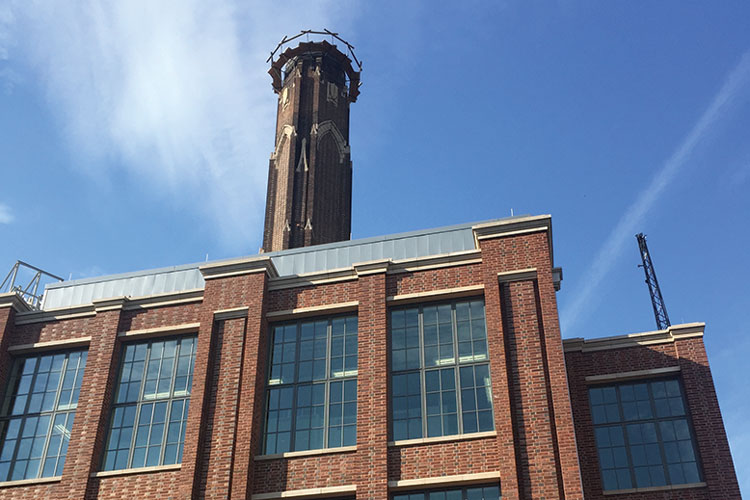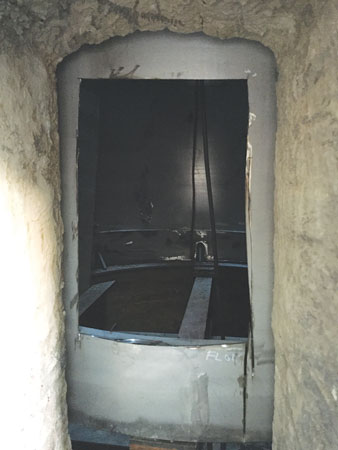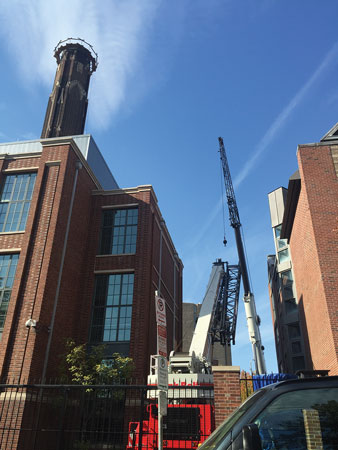
By Justin McCarthy and Gregory Boivin
At 1021 hours on October 17, 2015, New Haven (CT) Fire Communications dispatched Engine 6, led by Lieutenant Justin McCarthy; Squad 1, led by Captain Gregory Boivin; Paramedic Emergency Unit 2; and Car 34 (battalion chief) to a reported “long fall” at 120 Tower Parkway. On receipt of the alarm, companies were immediately updated that the fall was within a smokestack. Engine 6’s McCarthy was well aware of the address: 120 Tower Parkway is the Yale (University) Central Power Plant (YCPP) (photo 1).
The background information on this site goes back more than 90 years when Yale University built a coal-fired power generator to supply the campus with power and steam heat. Fast-forward to today. The YCPP provides more than 50 percent of the campus with steam heat, power, and chilled water using a gas-powered generator system. The YCPP provides enough power to supply 11,000 homes and now uses a recapturing system to provide clean energy. Over the past year, the power plant had been undergoing renovations designed to achieve its “greenhouse gas goal” before 2020.
The Incident
McCarthy:
It was a typical brisk, clear, fall day in New England with negligible wind conditions. As the first-due officer of Engine 6, I began a preplan review en route with the members on the rig since two of the three firefighters had fewer than 14 months on the job. The YCPP is preplanned to have us arrive on the Ashmun Street side of the building, which I communicated to my driver/operator. Our response to this location is less than three minutes. Immediately, we noted that no workers were awaiting our arrival on Ashmun Street. I redirected the crew to locate on the Tower Parkway entrance. On making the turn to Tower Parkway, we saw several construction subcontractors waiting to direct units in.
At this time, I heard Car 32, the on-duty deputy chief, add himself, an additional squad, and Truck 1 (a tower ladder) to the assignment. Staffing at this point on the alarm was 21. On reaching the base of the smokestack, I was informed that a worker had fallen from “almost the top.” My immediate assessment and recall of the preplan were that the tower was roughly 100 to 120 feet. I noted a scaffold around the top of the stack, but it was still unclear from where the worker had fallen. I advised all incoming companies that this was a full confined space assignment.
Immediately on reaching the site, I found more workers and instantly heard grinding tools. I assessed the area and noted workers operating in a confined space area at the base of the tower. I immediately stopped all cutting operations by construction crews. Despite their good intentions, I needed to stop and assess the operation because there were too many unknowns on our end.
One lesson I have learned over and over is that regardless of my rank, I am on their turf. These workers on site know what is what. The fire officer is the one who has to break down and separate good information from impulsive information. The workers on the site are most concerned about their injured friend. Our priority is our safety.
 |
| (1) Photos by Justin McCarthy. |
I was quickly advised that I would have a better view if I went to an area above the tower. Following a representative, I asked some questions: What was the worker doing? What is the environment in the tower? What other hazards do we need to know about? All reports were that access was the issue and that no other hazards were known.
Making my way up three and a half floors to a work area, I reported to crews that staging at the base would be best until I had a better assessment.
On reaching the work area, I quickly noted a large area that would be suitable for a rope operation if it became necessary. Getting to the edge, I saw that access down to the site was obstructed. Looking down approximately 45 feet, I noted one patient with severe injuries. I also had a would-be rescuer at the bottom with him. Quickly, I realized that he would be our “canary” in the sense that we did not put him down there and we would not quickly be able to get him out. Therefore, his ability to breathe, speak, and report up to me was proof that air quality was somewhat tenable. My first response was to use a large industrial blower fan to circulate fresh air through approximately a 30- to 40-foot tube down to the victim before meter readings could be taken. This was a primary concern, and it could be mitigated immediately.
The “would-be rescuer’s” initial report was that the patient was unresponsive. He also told me that he had no injuries and was just trying to help. This gave me the impression that we were in rescue mode because no matter what, we still had to retrieve the “would-be rescuer.” It had to be made perfectly clear to everyone operating on scene that we were not rushing into action. Ultimately, the emergency was not the result of something we caused; we were there to fix the problem as safely as we could.
Boivin:
I arrived on scene with Squad 1. It was determined that Plan A would be a cutting operation, the quickest and safest option based on my visual assessment, the lieutenant’s report, and the configuration of the workspace. The biggest issue was that Squad 1 would have to operate in a confined space. The work area was an old three- by two-foot cleanout for the stack, built with masonry construction that led into a new ¼-inch-thick stainless-steel-lined wall that prohibited access into the stack (photo 2).
As soon as metering was completed, the operation could begin. After evaluating the material and ensuring the main victim’s safety, the squad began cutting using rotary saws with metal blades. Because of the material being cut and the tightness of the space, the blades could be used only to the point where they were still about nine inches in diameter. This led to frequent blade changes (about every three minutes) and, at times, using angle grinders. As more companies arrived, we would attempt to institute a three-saw rotation.
The newer rotary saws with fixed guards prohibited squad members from adequately cutting in the tight space. The squad and truck companies maintained a constant assembly line of blade changing to reduce time loss. This problem was unexpected, so, initially, pneumatic grinders and reciprocating saws were also passed into the hole. However, it quickly became clear that these options would not be used because of the thickness of the material to be cut. We considered using cutting torches carried by the squad, but since stainless steel is a poor conductor, the torches were not a viable option.

As the cutting operation progressed using the rotary saws without fixed guards, we were preparing to implement “Plan B” as an alternative. Plan B was to lower a crane hook through the stack to my location, approximately 50 feet down; this would provide a substantial anchor point (photo 3). From this point, a descent control device would lower a rescuer to package the victim, and a mechanical advantage system would be used to retrieve the victim and the rescuer.
One squad was involved in the cutting operation, and in anticipation of Plan B, the need for more rope technicians led Command to request a mutual-aid squad from Hamden. While cutting continued, the members of Squad 2 worked to set up Plan B. The mutual-aid squad was staged on Ashmun Street in case Plan B was to be implemented.
The cutting operation was progressing: As long as a steady assembly line of fresh saws was available, the cutting was working. Members used the voice of the civilian in the stack as a guide to help them cut in the most effective areas; he could easily be heard through the steel. After several saw changes, a two- by three-foot hole was breached, and it was a clear shot into the stack.
Light was available from above my location. Two Squad 1 members quickly metered the air for contaminants from outside the stack. The readings were in normal ranges. The members entered the space. They quickly passed out the initial victim through the opening to fellow rescuers, who rapidly assessed the victim and provided advanced life support care. The members then assessed the second victim, the “civilian rescuer,” and assisted him out through the entry point. The two squad members followed.
After all parties were transported, a debriefing or tailboard talk was held on site. Members were asked about their injuries, issues, and concerns. Officers then addressed the members and explained the reasons for the actions that were taken, their thoughts on arrival, and the findings and actions of the various companies. A critical incident stress debriefing was planned for later in the day with the department’s employee assistance plan provider. Later, all companies met for a more formal discussion. The initial victim succumbed to his injuries at the hospital.
Lessons Learned and Reinforced
Overall, this incident was an example of teamwork and the benefits of proper training. The use of the incident command system alleviated much of the stress of having companies work independently. All companies worked fluidly to perform a swift and aggressive extrication.
However, a lesson learned from this experience was that the lack of a “unified” voice for the subcontractors created a barrier to mitigating the operation. If we had been able to quickly find a qualified representative from each group to “lock” at the command post, we would have been able to obtain answers to questions about the site, available tools, and the use of the crane more expeditiously. Most workers knew only about their specific job and responsibility. The workers on site were from several union-based subcontractors and lacked intercommunication. Each group had its own boss, work plan, and goal; the workers did not know what others on the site did. The workers with me above the stack were from the Ironworkers, the operating engineers (crane operators) were in another area, and the YCPP employees had limited interactions with subcontractors.

At hazmat incidents, it is common to create a “bullpen” of knowledgeable people at the site. We should consider doing the same for all types of incidents, including technical rescues. As noted, the people working on this site were a wealth of knowledge, but they were behind the fire line tape. If we could have had a representative from each group on site near the command post to answer our questions, we could have gathered solid information about the site and the crews’ capabilities in a timelier manner.
Another major issue was that we have preached for so long that “nothing from the site can be used by the fire department.” As a result, crews have come to believe that this is a hard rule that has no exceptions. Here, however, we had to think outside of the norm because of the work area and limited options. A more practical approach is to, instead, train the crews to use what may be available and how to determine what is safe to use. To be clear, if something is directly involved in the incident, it should not be used. However, in this case, we knew a large crane would be well beyond our standard 15:1 safety factor. The fire and rescue scene is always fluid and, at the end of the day, nothing can be ruled out.
JUSTIN MCCARTHY is a lieutenant in the New Haven (CT) Fire Department. Previously, he worked with the Westport and Wilton Fire Departments. He is a fire instructor for the Wolcott Regional Fire School. He has a BS degree in fire science from the University of New Haven and has cowritten Fire Engineering’s “Tactical Perspective” DVDs with Frank Ricci. He has presented at FDIC International and co-hosts the monthly “PJ Norwood Show” on FE Blog Talk Radio.
GREGORY BOIVIN is an 18-year veteran of the New Haven (CT) Fire Department, where he is a captain on Squad 1. He is a fire service instructor with Middlesex County Fire School and an educational assistant with the Gateway Community College fire science program.
Confined Space Rescue: Why Operations Fail
CONFINED SPACE INCIDENT: Is Your Department Ready?
Three Essentials for Trench Rescue Success
Fire Engineering Archives

